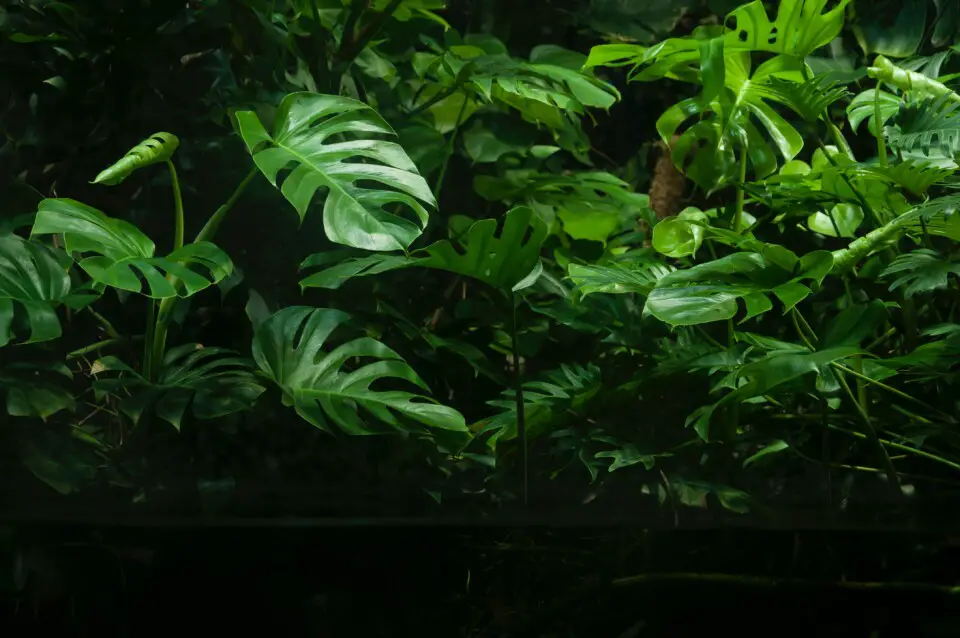Some links in the post are affiliate links and I get a commission from purchases made through some links found in the post.
When I first took a knife to my monstera, I felt overwhelmed. I almost couldn’t bring myself to do it. After all, how could I cut back such a magnificent plant?
Its leaves were broad, shiny, and green and beautified my living area in more ways than I could describe. But I wanted healthier growth, and someone had suggested I could achieve this by pruning the plant.
So, I painfully followed their instructions, and months later, I was happier about it. My monstera’s growth had exploded, and the leaves were even healthier than before.
Many people have concerns as to whether they should prune their monsteras and how they should go about it. If you’re wondering if it’s a good idea, the answer is yes.
However, there are certain situations when you should prune your monstera and others where you can give the plant a break.
The timing depends on why you are pruning a monstera. If you are doing it to eliminate dying and yellowing leaves, you can do so at any time.
For any other reason, prune your monstera right before the growing season in spring. The area you cut the monstera depends on why you are cutting the plant back.
I detail further when and how to prune the plant in this guide:
Should You Prune a Monstera?
Monsteras are generous plants whose growth spurts exceed those of most houseplants I have come across.
So, naturally, cutting them back may cross your mind. But should you do it? The answer is yes if you can relate to any of the following categories:
1) Your Plant has Yellow or Dying Leaves
 Dying leaves are always unsightly and can take away from the allure of your overall healthy plant. However, you should question the cause of the dying leaves.
Dying leaves are always unsightly and can take away from the allure of your overall healthy plant. However, you should question the cause of the dying leaves.
Are they dying due to old age, or is there more to it? Sometimes, the plant has dying leaves because it does not have adequate access to water, light, and nutrients.
And even if you cut back the dying leaves, the plant will keep producing more until you deal with the problem. The same goes for yellowing leaves.
Find the cause (e.g., pest infestations, overwatering, poor soil composition) and fix it. But in the meantime, you can always cut back the unsightly leaves and enjoy a healthier appearance.
2) Your Monstera is Becoming Too Big
Monsteras are generally big plants that can become quite large when left in the right conditions.
Unfortunately, while this growth might be welcome, it might not be what you want because of two main factors.
One is that such fast growth takes up more space than you may have originally intended.
Two is that this growth gives rise to lateral vines that may look off when left to grow as they wish. In this case, you might want to cut the monstera back to tame its growth patterns.
3) Your Monstera Looks Leggy
Leggy growth results from poor light exposure in most cases. Thus, even if you prune the leggy growth, it might continue unless you move the plant to a spot with better light exposure.
That said, you can always eliminate the leggy growth by cutting it back and making way for fuller development.
4) You Want to Shape your Monstera
Have you recently realized your monstera could do with a makeover? The easiest way to do this is by pruning it because you can decide what stays and what goes.
Plus, it also tames the wild growth and keeps the plant in check.
5) You Want to Protect your Monstera from Being Rootbound
The more your plant grows, the more its nutritional and water needs will grow. As such, its roots will keep expanding with its vertical and horizontal growth.
You can keep the roots in check by pruning them, which would also slow the plant’s growth.
6) Your Monstera has Unsightly Aerial Roots
Monsteras develop aerial roots to help them attach to tree trunks and grow taller in the wild, where they can reach more light.
But indoors, this root development may not be as aesthetically pleasing as you would like. In that case, you can always cut them back.
7) You want to Grow Cuttings
You can always grow more monsteras by acquiring stem cuttings from parent plants. If you wish to do so, you can prune the healthiest parts of the plant and use them for this.
See? There are several reasons one would want to cut back an otherwise healthy monstera. But before you start cutting the leaves and vines, please read on for precautions and instructions on how to go about it.
When Should You Prune a Monstera?
The timing depends on why you are pruning a monstera. If you are doing it to eliminate dying and yellowing leaves, you can do so at any time.
Doing this is beneficial to the plant as it enables it to conserve its energy to grow rather than heal the dying leaves.
But if you’re pruning for any other reasons mentioned above, do it right before the growing season starts in the spring. That gives it a chance to recover and start growing before the end of the season.
How Often Should You Prune a Monstera?
Pruning is essential to the growth of the monstera, but there are caveats to this care routine. Young plants do not need pruning more than once a year.
Their leaves cannot produce enough food to give them the energy to withstand this kind of continuous shock.
Unless you are cutting off dying and yellow leaves, only prune them once annually in the spring. Older plants are more resilient, and you can cut them back monthly to control their growth.
How To Prune a Monstera
Before you prune your monstera, you must be aware of a few things.
1) The monstera produces calcium oxalates in its sap. These substances are irritating to the skin and can poison you when ingested.
As such, you must ensure you reduce your contact with them as much as possible. I advise that you wash your hands and wear tough gardening gloves when handling the monstera.
And if some sap gets on your skin, wash it off with warm soapy water as soon as possible to avoid irritation. Also, keep the cuttings out of reach if you share the home with pets and children.
2) The area you cut in the monstera depends on why you are cutting the plant back. For example, when you want to cut back the plant and use the cutting for new growth, you must do so at the internode.
That should give the plant new space to grow. If you’re doing it to get rid of dying leaves, you can cut above the node so the new growth will also assume a similar direction.
3) You must always use sharp and sterilized tools to cut the plant back. A sharp tool makes a clean-cut, preventing bruising, and thus reducing the likelihood of pest and disease infestation.
A sterile tool ensures you do not introduce pathogens to the plant. Do not use any unclean tools on the plant. And when cutting back any diseased parts, always sterilize the tool between each cut to avoid spreading the disease.
Now that you know what you must consider, let’s get into different ways and reasons to prune your monstera:
How Do You Prune a Monstera with Yellow or Dying Leaves?
The best way to get rid of dying leaves is to cut them off from the main stem. Track where the leaf stems meet the main branches and snip them off at that point.
Cut as close to the base of the stem as possible to avoid leaving stems on the plant, as these would be unsightly. You cannot use these leaves as fresh cuttings but can use them as compost, as I will later show you.
How Do You Prune an Overgrown Monstera?
You might want to cut the plant back a lot. However, every time you cut the plant, you wound it. And the more you wound it, the more time it takes to heal from the cuts.
Plus, this also exposes it to a range of pests and diseases. The idea here is to find the nodes that have given rise to the most stems and leaves.
Cutting the monstera at this point will enable you to reduce its breadth without setting it back too much. You can do this by:
- Taming the lateral vine: Lateral vines emanate from the main stem, and when left untouched, they often give rise to more growth. You can cut these off at the main stem or any point along their lengths. Make sure you do this above a node.
- Topping off the monstera: If vertical growth is your key concern, you can cut off all the growth above the desired height. As with the lateral vine, you should make this cut above the node.
- Cutting back its roots: Did you know you can prune your monstera’s roots? That’s right – you can attack the one thing that gives your plant the nutrients it needs to grow bigger. All you need to do is wet the soil around the root ball, then wiggle the plant out of its pot. Cut back the lateral roots by a third of their length and put the plant back in its pot. It will take a while to acclimate to its new condition, which will slow its growth.
In each case, you will need to give the plant time to get used to the changes.
How Do You Prune a Leggy Monstera?
 The idea here is to encourage better and fuller growth. You can do this by cutting the leggy growth just above the node. For example, you can cut the stem off above the node.
The idea here is to encourage better and fuller growth. You can do this by cutting the leggy growth just above the node. For example, you can cut the stem off above the node.
Or, if you want to prune a leggy vine, do so above the node. The new growth will emanate from the nodes rather than the internodes, hence the emphasis on making the cut at the nodes.
Once you have done so, move the monstera to better lighting, i.e., bright and indirect light.
How Do I Shape My Monstera?
Shaping your monstera is essential, especially when you do not have the space to house an overgrown monstera. And it increases the aesthetic appeal of the plant.
All you need is to inspect the plant and identify parts that look off or have overgrown. Then you can cut them off at their bases near the main stem.
Please avoid bruising the stem, as this would only be a catalyst to an adverse chain reaction. Instead, cut back the leaves and vines near the stem.
When you cut them above the node, new growth will emanate from the nodes. So, you can use pruning to direct growth in your preferred direction.
How Do You Prune Monstera Roots?
Pruning the monstera roots is relatively easy. Start by wetting the soil around the root ball a day before you prune the roots. That will make it easier to wiggle the plant out of the pot.
Then tug on the plant, remove it from the pot, and take a good look at its roots. It will have one main root with lateral roots on the side.
Cut off these roots by a third of their length but do not touch the main root. Then repot the monstera in a fresh potting mix and allow it to keep growing under sufficient lighting and water.
How Do You Prune Monstera’s Aerial Roots?
You can cut aerial roots by aiming to do so as near the node as you can without hitting the node. Otherwise, you can hurt the node which would leave the stem exposed to various pests and diseases.
Cut off as many of the aerial roots as you see fit. It will only bar the monstera from attaching to moss poles and other structures but will not affect the healthy development of the plant.
How Do You Prune a Monstera For Propagation?
A monstera cutting must have at least one node for it to root. As such, you must cut off stem parts that have nodes. Start by locating a healthy vine that has at least one healthy leaf attached to it.
Then find the spot where this vine attaches to the stem and locate the node. You should cut off the vine half an inch below the node so that new growth can emanate from it.
For more help on pruning, check out this video on monstera pruning below
What Can You Do with The Pruned Monstera Leaves?
Depending on why you pruned the monstera, you will end up with many cuttings that you might not know how you can use. I have found two great ways you can put this leaf matter to good use.
You Can Propagate the Cuttings
Did you know that you can grow new monsteras out of cuttings? These plants are so amazing that having an extra one in the home never hurts.
Remember, though, that as monsteras grow, you need to cut them back (roots or leaves) to keep them in their pots. And to help with their appearance.
Moreover, these plants take up a lot of space, and you might want to hold back on adding more if you have any space concerns. That said, you can proceed to propagate new plants as shown below:
- Choose a rooting medium: Soil and water work well enough, and your choice should thus come down to preference. Rooting the monstera cuttings in soil enables you to keep growing them in the same medium even when they have established. And growing them in water allows you to gauge their growth even in the developmental stages. Plus, it eliminates the risk of root rot.
- Place the cuttings in the chosen medium and give them time to root. The period should not be long, provided the medium has access to light and water.
Once the cuttings have formed enough roots to establish in the soil, you can find a small pot and start propagating them in it. Then you can change the pot once every year until the plant matures enough.
You Can Use the Leaves as Food
 In the wild, plants survive by feeding off their dead leaves. That’s because the leaves decay and release their nutrients into the ground.
In the wild, plants survive by feeding off their dead leaves. That’s because the leaves decay and release their nutrients into the ground.
You can replicate a similar environment by relying on the fresh cuttings, which make up the green matter in any compost.
Collect as many of the leaves as you can and mix them with other green matter from your kitchen, e.g., fresh peels, grass cuttings, etc.
These decompose fast and trigger the reactions required to turn the leaves into food for the monstera.
Place these materials in a pit or a bag where they can decompose and add a lot of brown matter, e.g., dead twigs, paper, etc. Then mix the materials, wet them (not soak them), and leave them to decompose.
You should turn the mix at least twice a month and ensure it has adequate air circulation.
When the mix finally stops emitting heat, you will know that the compost is ready. That can take several weeks. If you need to accelerate the process, you can always use natural fertilizer to get things started.
Final Thoughts
Did you know that pruning is also a self-care technique? You might think that by pruning your monstera, you are helping the plant.
But while that may be true, science shows that spending time caring for plants is beneficial to our well-being. So, the next time you might be feeling down and need a pick-me-up, you can try cutting back your monstera.
Happy Gardening!

